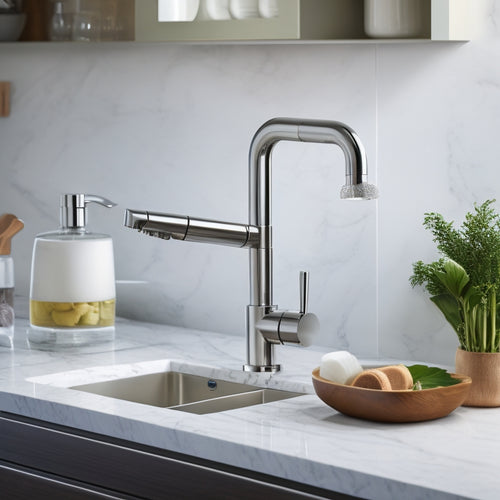
3 Quick Fixes for Cluttered Kitchen Countertops
Share
Clear off your countertops by removing everything and sorting items into categories. Identify the items causing clutter and assess how often you use them. Next, optimize your kitchen workflow by positioning tools and utensils strategically and considering a kitchen cart or island for extra space. Finally, create a clutter-free zone by designating a landing strip for essentials and using decorative trays or baskets for organization. By implementing these quick fixes, you'll be well on your way to a more functional and peaceful kitchen - and there are even more ways to refine your space once you get started.
Key Takeaways
• Remove all items from kitchen countertops and sort them into categories to identify items causing clutter and assess frequency of use.
• Identify daily clutter contributors and develop strategies to prevent future clutter by examining daily routine and habits.
• Implement the 'golden triangle' concept by positioning tools and utensils strategically to optimize kitchen workflow and efficiency.
• Designate a 'landing strip' for essentials and utilize decorative trays or baskets for organization to maintain functionality alongside aesthetics.
• Establish a 'one in, one out' policy for new items to prevent clutter resurgence and maintain a clutter-free environment.
Clear Off Counter Clutter Now
Start by removing everything from your kitchen countertops and sorting items into categories, such as 'keep,' 'donate,' and 'discard,' to get a clear view of what's causing the clutter. This step is important in identifying the root of the problem.
As you sort, take note of the items that are contributing to the clutter. Are they items you use daily, or are they simply taking up space? Be honest with yourself - if you haven't used it in the past month, it's probably safe to get rid of it.
Next, examine your daily routine and how it contributes to the clutter. Do you tend to leave dirty dishes overnight, or do you have a habit of leaving mail and papers on the counter? Identifying your clutter triggers will help you develop strategies to prevent clutter from building up in the future.
Optimize Your Kitchen Workflow
Once you've cleared the clutter, take a closer look at how you move around your kitchen and identify areas where workflow can be improved. You'll likely find that certain tasks, like food prep or cooking, require you to constantly move between different areas of the kitchen.
To optimize your workflow, consider the 'golden triangle' concept, where your sink, stove, and refrigerator form the points of a triangle. This efficient design helps reduce walking distances and makes cooking more convenient.
Next, think about the tasks you perform most frequently and position your kitchen tools and utensils accordingly. For example, store your most-used spices near the stove or keep your coffee maker near the sink. These kitchen hacks can save you time and energy in the long run.
Additionally, consider investing in a kitchen cart or island to provide extra counter space and storage. By streamlining your kitchen workflow, you'll be able to cook and prepare meals more efficiently, making mealtime less stressful and more enjoyable.
Create a Clutter-Free Zone
With your kitchen workflow optimized, focus on creating a clutter-free zone by designating a specific area, such as a countertop or shelf, as a 'landing strip' where you can place essential items like keys, wallets, and bags.
This designated space will serve as a catch-all for daily essentials, keeping them organized and out of the way. For design inspiration, consider a decorative tray or basket to corral small items, adding a touch of style to your kitchen.
When decluttering, remember that a clutter-free zone isn't just about aesthetics; it's also about functionality. By designating a specific area for daily essentials, you'll reduce the likelihood of clutter creeping back onto your countertops.
To maintain your new space, implement a 'one in, one out' policy, where you remove an item every time you add a new one. By doing so, you'll keep your landing strip organized and prevent clutter from building up again.
With these decluttering hacks, you'll be well on your way to a kitchen that's both beautiful and functional.
Frequently Asked Questions
Can I Use a Kitchen Cart to Increase Counter Space?
You can absolutely use a kitchen cart to increase counter space! Consider a cart style that fits your kitchen's flow, or opt for an island option that provides extra storage and seating for a cozy gathering spot.
How Often Should I Clean My Kitchen Countertops?
You'll want to establish daily habits, like wiping down counters after meals, and create a cleaning schedule, such as sanitizing surfaces weekly, to keep your kitchen countertops clean, clutter-free, and germ-free.
Are There Any Countertop Materials That Resist Clutter?
You'll find that certain countertop materials, like quartz and stainless steel, resist clutter with their durability and easy cleaning. Consider applying countertop coatings to enhance material durability, making maintenance a breeze for you.
Can a Utensil Organizer Be Mounted on the Wall?
You can easily mount a utensil organizer on the wall, creating a convenient utensil placement and adding a functional touch to your wall decor, freeing up counter space and streamlining your kitchen workflow.
Will a Cluttered Kitchen Impact My Home's Resale Value?
You walk into a cluttered kitchen, and your mind screams "chaos!" - a feeling potential buyers will share. Seller anxiety spikes as buyer psychology whispers "disorganization = lack of maintenance" - a perception that can tank your home's resale value.
Related Posts
-

Revamp Your Kitchen Storage With These Tips
A well-organized kitchen storage system is essential to a clutter-free and functional cooking space. To enhance your ...
-

Revolutionize Your Kitchen Sink With Must-Haves
Elevate your kitchen sink experience with must-have essentials that prioritize organization, efficiency, and style. S...

